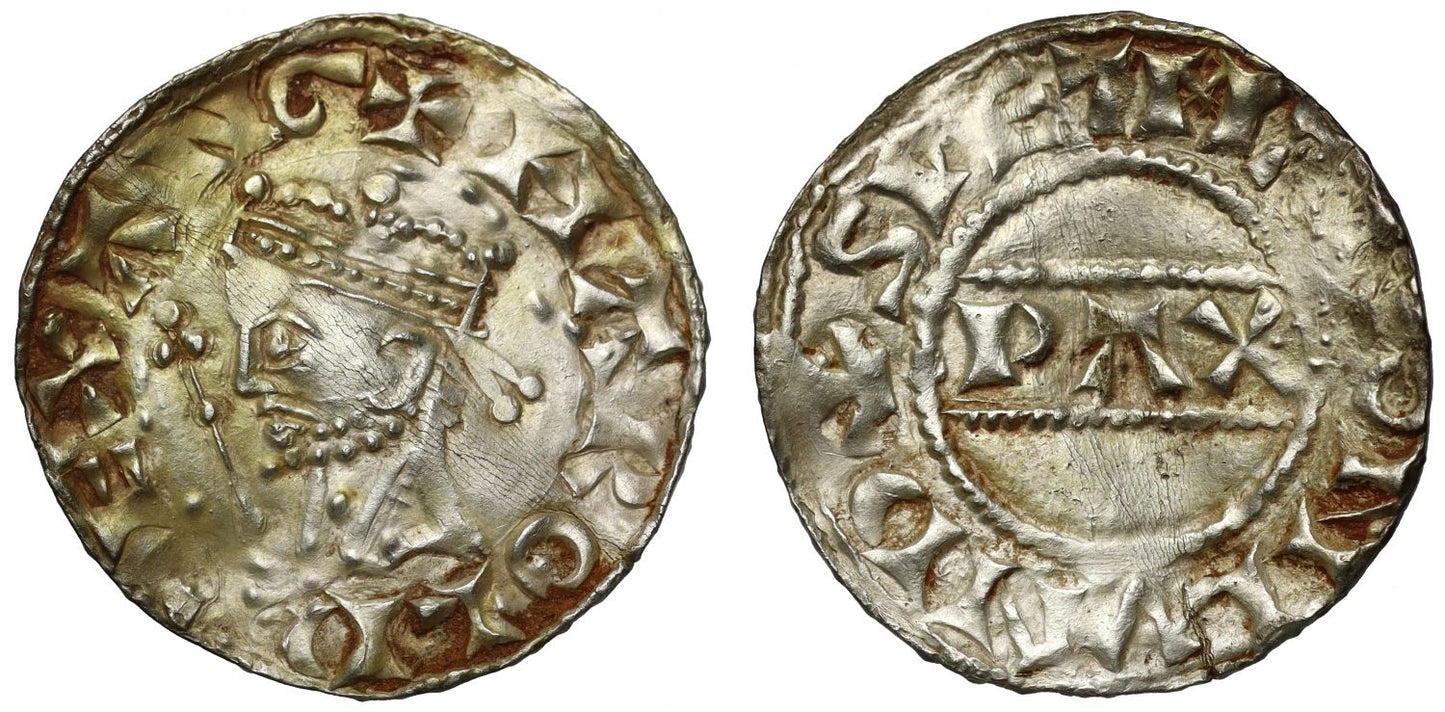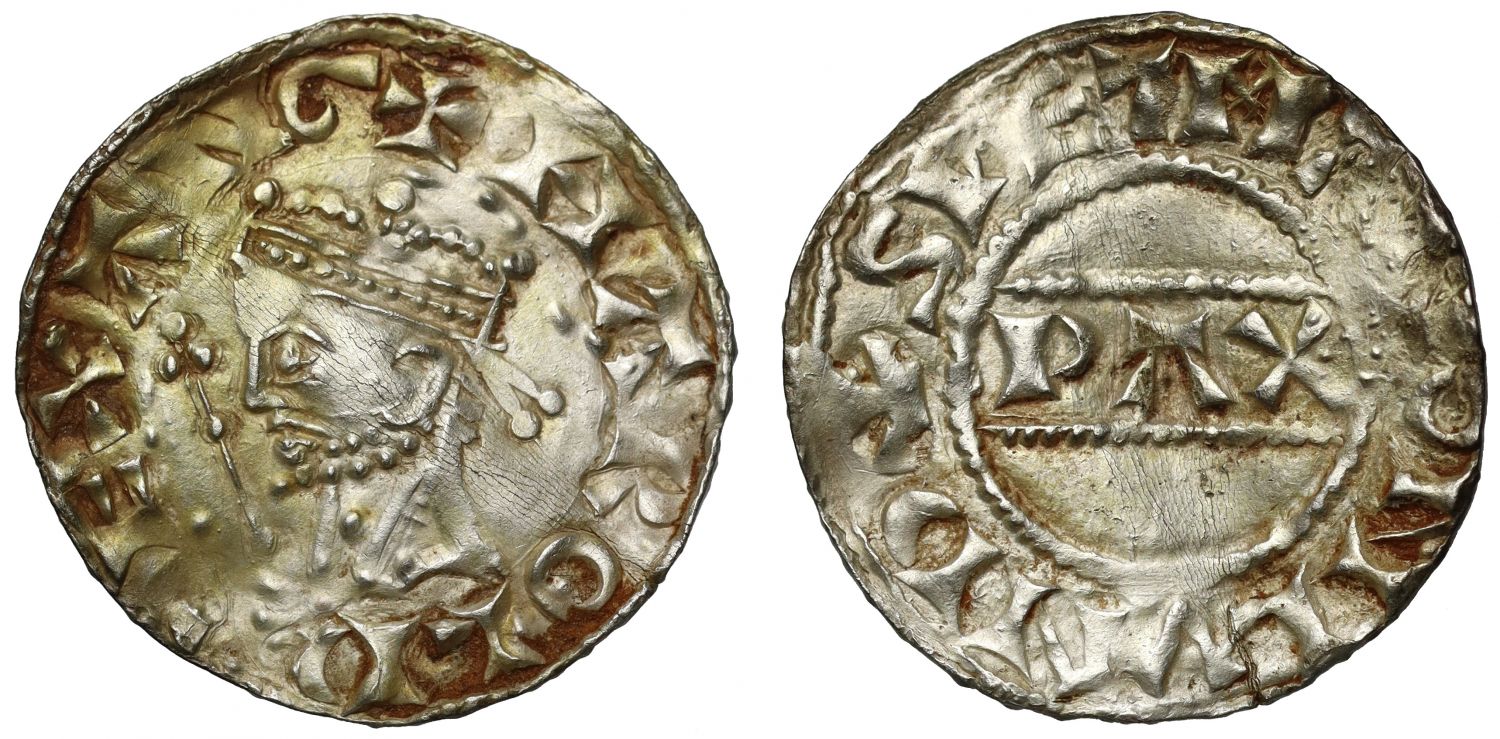FAQs
What makes a coin valuable?
I have coins to sell, what’s the next step?
How will my purchases be shipped?
What happens if I’m not entirely happy with my purchase?
Harold II Penny 'PAX' type, London mint, moneyer Swetman
Harold II (6th Jan-14th Oct 1066), silver Penny, London Mint, Moneyer Swetman, crowned bust left with sceptre, legend and beaded outer circle surrounding, legend commences at top, +HAROLD REX ANG, rev. PAX between beaded horizontal lines at centre, beaded circles and legend surrounding, legend commences at left +SVETMAN ON LVND, weight 1.32g (BMC type I, 7; N.836; S.1186). Unevenly toned, trace of deposits on undulating flan, with an excellent portrait, good very fine.
The legends translate as "Harold King of the English" on the obverse and "Swetman of London" on the reverse with "Peace" across the centre.
According to North the London Mint operated with up to eight moneyers in this reign for this sole type.
Harold "Godwinson" the son of Godwin of Wessex born circa 1022, rose to prominence in the reign of Edward the Confessor, especially after his Father passed away in 1053 becoming Chief Minister and Commander in Chief of England and the second richest man after Edward himself. Harold waged successful campaigns against the Welsh and supressed revolts, notably that of his brother Tostig of Northumbria in 1065 who he exiled. At this time the French sources say Harold visited with William of Normandy possibly to negotiate the release of his brother Wulfnoth and nephew who were held hostage. Harold apparently accompanied William on an expedition to Brittaney, bravely saving some soldiers from quicksand at Mont St Michel; for which William knighted him, effectively making him "his man" and to swear an allegiance to him as heir to England; all unknowingly over some holy relics as shown in the Bayeux Tapestry. Harold succeeded to the English throne on the 4th January ahead of Edgar Aethling who was 12-14 years of age, and he was crowned on the 5th January 1066 at Westminster Abbey, the first such event in the new building. Harold was married to Edith "Swan-neck" and had three sons and two daughters, but by the Summer of 1066 with the threat of William of Normandy in the south, and Norwegian Harald Hardradi from the north, to gain the allegiance of the powerful northern Earls Edwin and Morcar, he set aside his wife to marry their sister Edith, the widow of Gruffyd of Wales. Harold's exiled brother Tostig briefly raided the coast of Norfolk but was driven off to Scotland to his ally Malcolm III; where he was ideally placed to join Harald Hardradi, who first landed shortly after in the Orkneys. Earls Edwin and Morcar marched north and were defeated by Harald at Gate Fulford on the 20th September 1066 who then took York. The invaders moved on and were caught by Harold II and his army unawares on the River Derwent at Stamford Bridge, where they were defeated on 25th September with both Harald and Tostig killed.
Meanwhile on the 27th September William set sail and landed at Pevensey Bay, East Sussex ravaging the county to lure Harold II to battle from over two hundred miles from the north. The decisive encounter took place on the 14th October 1066 with Harold killed in the final attack of the day, having either been cut down by a horseman or suffering from the injury of the arrow in the eye, his ex-wife Edith Swan-neck had to identify him, he was no older than 44. In London the young Edgar Aethling grandson of Edmund Ironside was proclaimed King by the Archbishop of York and the Earls of Mercia and Northumbria, but it was merely a waiting game until a surrender to William at Berkhamsted. Edgar went to Scotland, where his sister Margaret had married King Malcolm III, being later involved in a failed revolt in 1068; and then survived till as late as 1125. He was therefore aware that his niece Edith of Scotland, also known as Matilda, married into the Norman family as wife of King Henry I. His sister Margaret was later canonized as by Pope Innocent IV in 1250 as well as being mother to two Scottish Kings.
Capital City London upon the River Thames following Roman occupation, minted some of the earliest Saxon coins with gold Thrymsas and silver denarii with a "Londuniu" signature. Mercian Kings beginning with Offa minted coins there, but the first coin to actually say City of London upon it is the unique Ludica portrait Penny that was found in 2016, followed by subsequent coins of Ecgberht. In 871 the Danes wintered in London for the first time but was King Alfred of Wessex who settled and fortified the capital circa 880 to resist further invasions. Edward the Elder incorporated the City in Wessex in 911 and it resisted a major attack in the reign of Aethelred II in 1009. However, London submitted to the Danish Swein in 1013, but three years later the citizens accepted Eadmund Ironside as King and resisted a siege by Canute.
Later unsettled times occurred in the anarchy period of the reign of King Stephen, remaining loyal to the King except for a few months in 1141 when Empress Matilda was admitted but within a short time expelled. Coinage activity here has been mostly constant throughout history from the Romans until the reign of our current Queen and only moving out to Wales from 1969.
Provenance:
Found Braintree area, Summer 2019.
Ex Braintree Hoard, Noonans, 21st February 2024, lot 1072.
FAQs
What makes a coin valuable?
I have coins to sell, what’s the next step?
How will my purchases be shipped?
What happens if I’m not entirely happy with my purchase?













